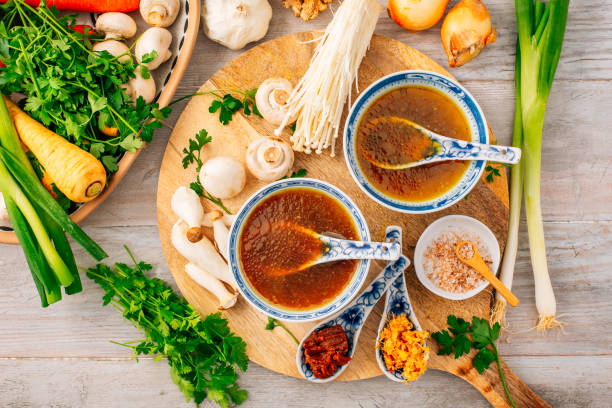Umami Unleashed: Exploring the Fifth Taste Sensation
Prepare your taste buds for a culinary journey into the enigmatic world of umami. This elusive fifth taste has captivated chefs and food enthusiasts alike, transforming the way we perceive flavor. Join us as we delve into the science, history, and culinary applications of umami, uncovering its secrets and learning how to harness its power in your own kitchen.

The Science of Savory
At its core, umami is a result of specific compounds interacting with our taste receptors. Glutamates, inosinates, and guanylates are the primary culprits behind the umami sensation. These compounds are found naturally in various foods, with some containing higher concentrations than others. When we consume umami-rich foods, these compounds bind to specialized receptors on our tongues, triggering a cascade of flavors that our brains interpret as deeply satisfying and delicious. Interestingly, the umami taste is not localized to a specific area of the tongue, as once believed with other tastes. Instead, umami receptors are distributed throughout the oral cavity, allowing for a full-bodied flavor experience. This unique interaction with our taste buds explains why umami-rich foods are often described as mouth-watering and why they can enhance the overall palatability of a dish.
Umami All-Stars: Nature’s Flavor Bombs
While umami can be found in various foods, some ingredients stand out as umami powerhouses. Aged cheeses like Parmesan and aged cheddar are rich in glutamates, delivering a punch of savory flavor. Tomatoes, especially when cooked or sun-dried, concentrate their natural umami compounds, making them a versatile ingredient in many cuisines. Mushrooms, particularly dried varieties like shiitake, are umami gold mines, adding depth and complexity to vegetarian and meat-based dishes alike. Fermented foods such as soy sauce, miso, and kimchi are also excellent sources of umami, thanks to the breakdown of proteins during the fermentation process. Meat and fish, especially when aged or cured, contain high levels of inosinates and glutamates, contributing to their satisfying flavors. By incorporating these umami-rich ingredients into your cooking, you can create dishes with remarkable depth and complexity that will leave your diners craving more.
Umami in Action: Culinary Applications
Harnessing the power of umami in your cooking can transform ordinary dishes into extraordinary culinary experiences. One simple technique is to use umami-rich ingredients as flavor enhancers. For example, adding a splash of fish sauce to a stir-fry or a sprinkle of nutritional yeast to roasted vegetables can boost their savory qualities without overpowering the dish. Umami synergy is another powerful tool in a chef’s arsenal. Combining different umami-rich ingredients can create a flavor explosion greater than the sum of its parts. Think of the classic Italian pairing of tomatoes and Parmesan cheese, or the Japanese dashi made from kombu seaweed and bonito flakes. Slow cooking and braising techniques can also help develop umami flavors by breaking down proteins and concentrating glutamates. Don’t forget about plant-based umami sources for vegetarian and vegan dishes – roasted mushrooms, sun-dried tomatoes, and fermented vegetables can add incredible depth to meat-free meals.
Global Umami: A Taste Without Borders
While umami may have been formally identified in Japan, its presence in global cuisines is ubiquitous. In Chinese cuisine, fermented black beans and oyster sauce provide rich umami notes to stir-fries and braises. Italian cooks have long relied on Parmigiano-Reggiano and anchovies to add depth to their dishes. In Southeast Asia, fish sauce is a staple umami booster, while in Mexico, mole sauces often incorporate umami-rich ingredients like dried chilies and chocolate. Even in Western cuisine, where umami wasn’t traditionally recognized, classic dishes like French onion soup (with its caramelized onions and aged cheese) and British Marmite spread showcase the power of savory flavors. By exploring umami in various culinary traditions, we can expand our palates and discover new ways to incorporate this fascinating taste into our own cooking adventures.
Umami Wisdom: Tips and Tricks
- Boost umami in vegetarian dishes by using dried mushrooms, nutritional yeast, or miso paste.
- Create an umami salt by blending sea salt with dried seaweed for an instant flavor enhancer.
- Save Parmesan rinds to add to soups and stews for a rich umami base.
- Experiment with umami-rich condiments like anchovy paste or Worcestershire sauce in marinades and dressings.
- Caramelize onions slowly to develop their natural umami compounds.
- Use tomato paste to add depth to sauces and stews, even in non-tomato based dishes.
- Try fermenting your own vegetables to create unique umami-packed ingredients.
- Incorporate aged cheeses into unexpected dishes, like grating them over salads or into bread doughs.
As we conclude our exploration of umami, it’s clear that this fifth taste is more than just a culinary buzzword – it’s a gateway to a whole new world of flavor possibilities. By understanding the science behind umami and learning to identify and combine umami-rich ingredients, we can elevate our cooking to new heights. Whether you’re a professional chef or a curious home cook, embracing umami will undoubtedly transform your approach to food. So go forth and experiment, letting your taste buds guide you through the savory, satisfying landscape of umami. Your culinary creations will never be the same again.






